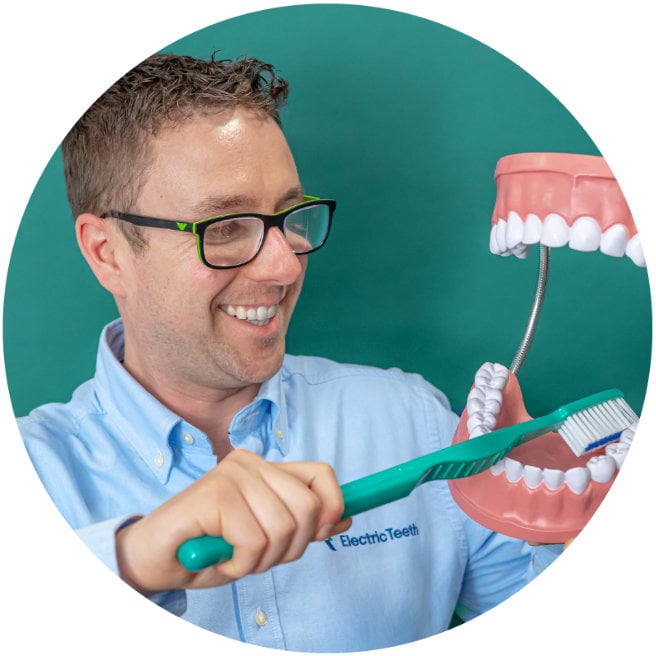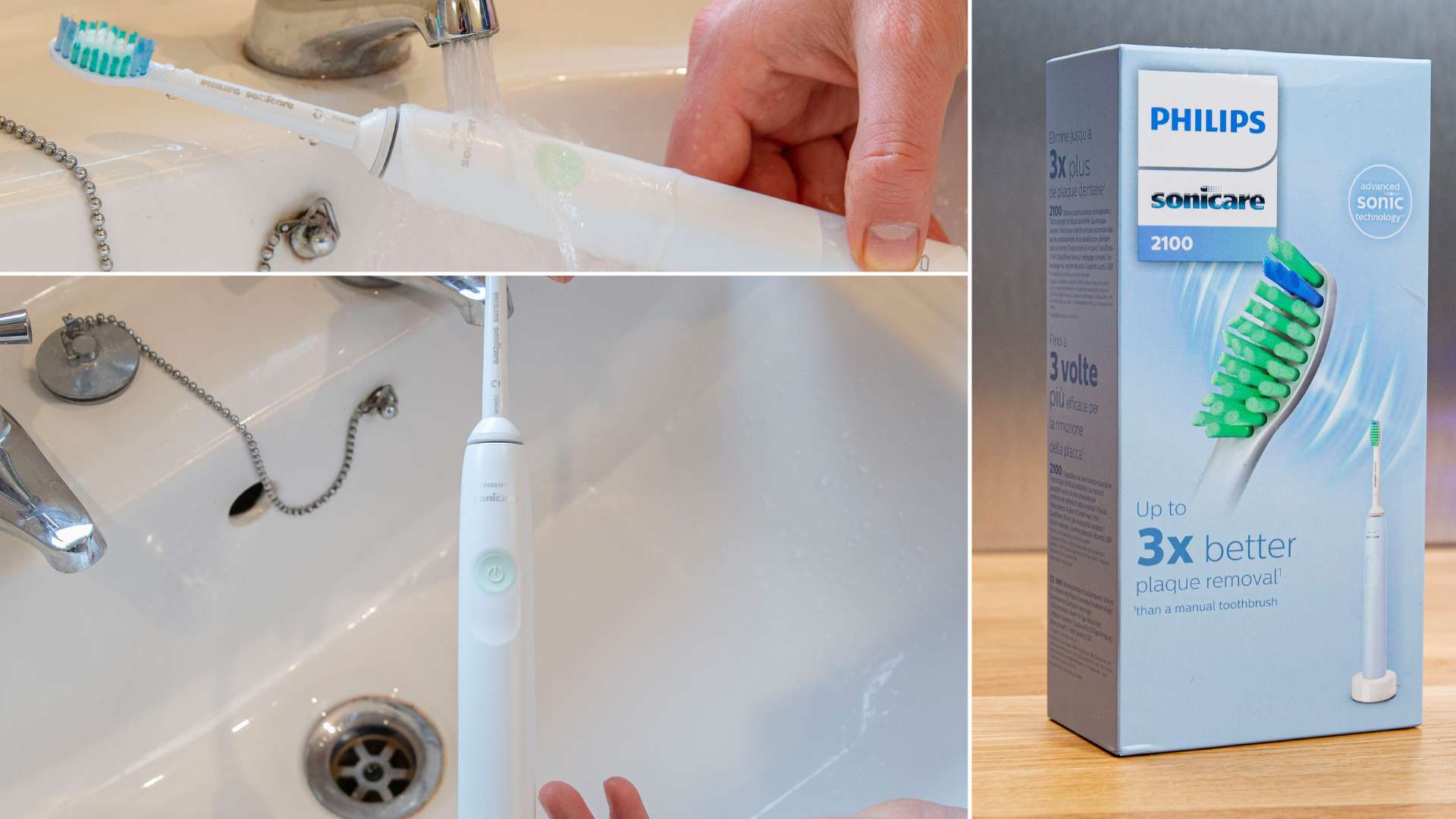
This video is of the UK version of the 2100. There are subtle differences, notably the included brush head and price. But the general message is the same.
The best budget Sonicare electric toothbrush
Competitively priced, the 2100 Series is the best Sonicare toothbrush on a budget.
The slim handled brush cleans the teeth well. It boasts a 2 minute timer and pacer, which are essential features of any good electric toothbrush.
The biggest downside is that it lacks a pressure sensor, which is a useful feature for preventing you from brushing too hard.

Simple to use – 1 cleaning mode |
No pressure sensor |

Slim, stylish handle – easy to keep clean |
USB charger prevents in bathroom charging |

USB charging stand makes it more convenient for some |
Sonic motor configured differently to premium models |

Affordable with few compromises
$60 is about what you should pay, despite a $70 suggested retail price.
At half the cost, it’s pretty fair and subsequently, the 2100 is our top choice Sonicare electric toothbrush for those on a budget.
Replacement brush heads cost around $12 each. This makes the 3 year ownership total about $192.
It’s not bad, but our top recommended electric toothbrush the Oral-B Pro 2 2000 works out at $157. This is because Oral-B heads are nearly half the cost.
Cheap Sonicare heads are available if you buy generic, off-brand heads. They are not made by Philips but are compatible with the 2100 Series. You can save $5 per head on average.
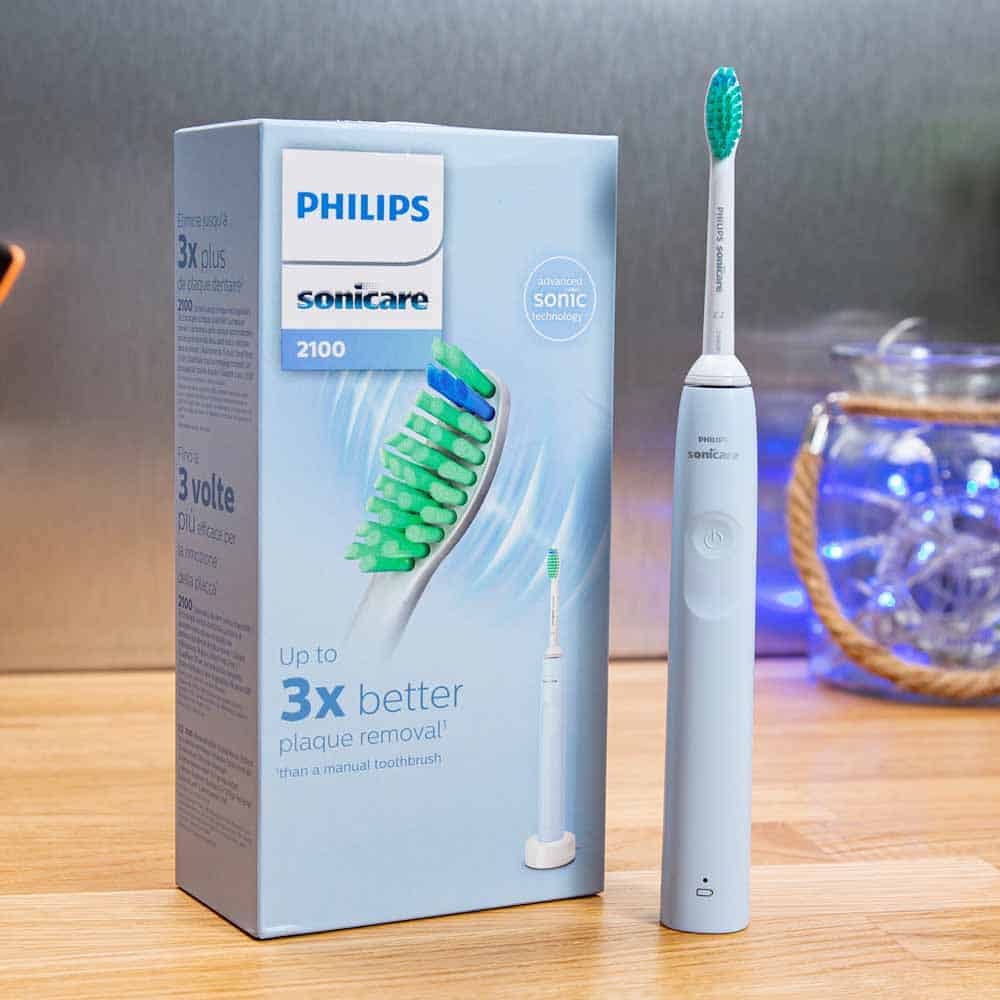
Simple to use with a slim and minimal design
The 2100 feels surprisingly premium despite the affordable price.
Durable and quality feeling in the hand
It is slimmer and lighter in the palm than previous cheap Sonicare brushes and it looks more appealing too.
Available in 2 colours, sugar rose (pink) and light blue the water resistant plastic handle has a slightly squared design to it. This helps give a secure in hand feel and allows the palm to grip the brush better given the lack of textured surfaces on the handle itself.
The matt finish to the plastic looks smart and there is a distinct lack of gloss finishes, which can make a brush look cheap. Aesthetically, it looks better than comparable Oral-B models in my opinion.
Able to stand upright on a countertop, the brush shouldn’t roll easily when laid flat thanks to 2 raised mouldings on the back of the handle.
Squeezing the handle doesn’t result in any dubious sounding creaks or groans from the plastic.
The minimal design looks good and does make it easier to keep clean.
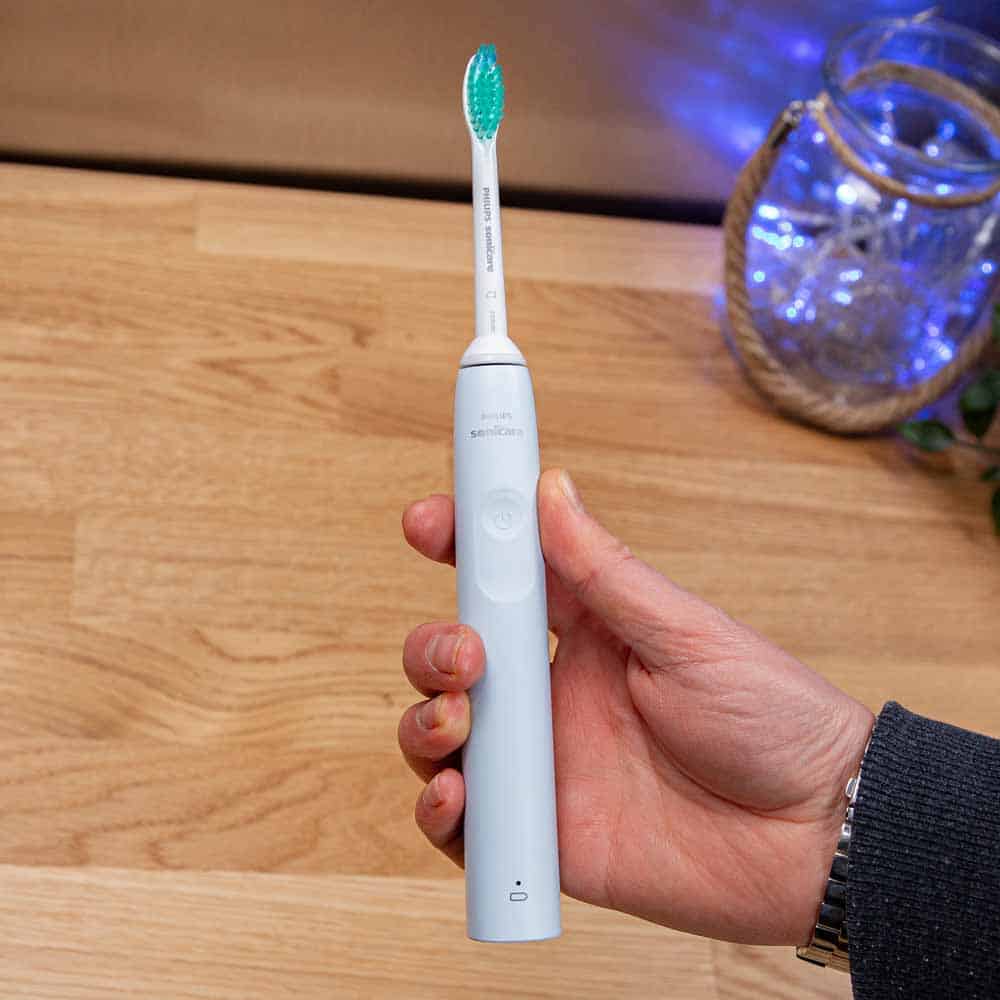
The power button gives a nice clicky feedback
Colour matched to the handle of the 2100, the concave shaped power button doesn’t stand out quite like it does on other models.
With a rubber finish and power icon embossed, it is easily detected by the fingertip and when pressed gives reassuring feedback whilst producing a clicky sound.
It isn’t very firm, great if you suffer from arthritis and painful joints.
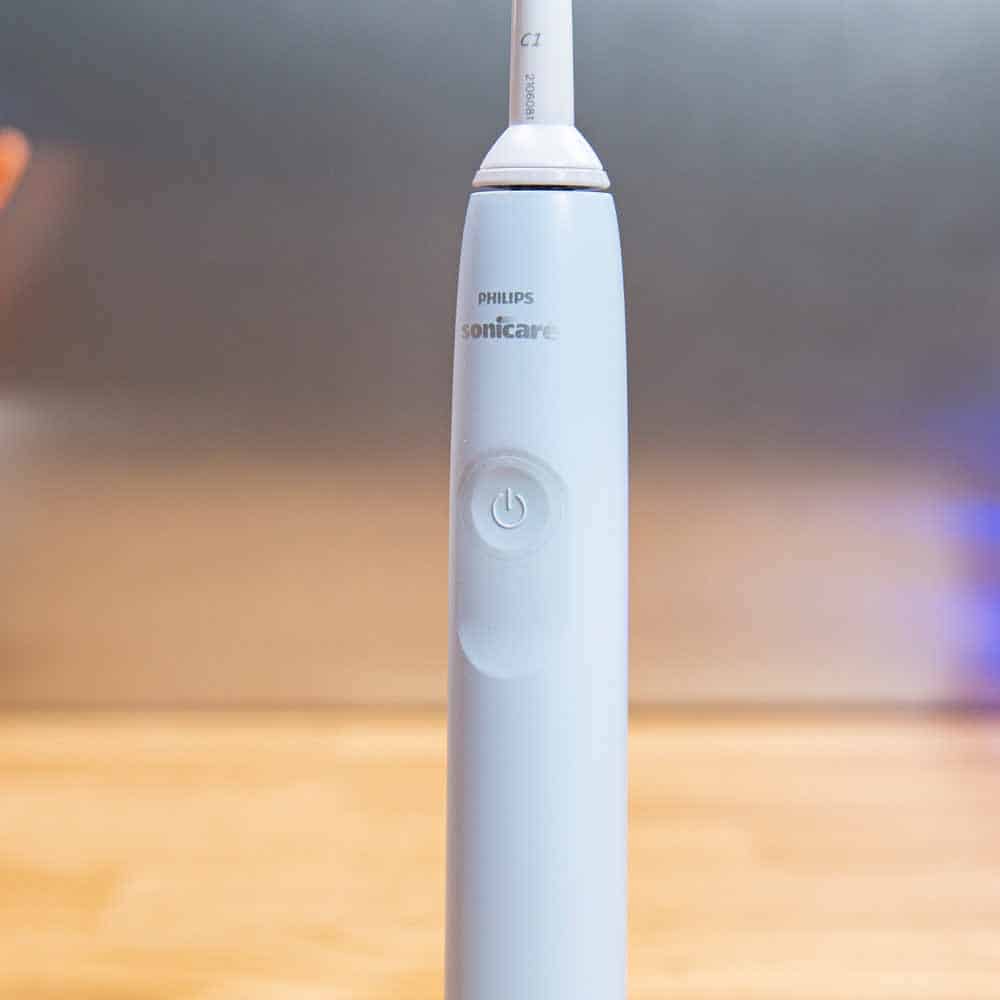
1 cleaning mode
Good oral care routines don’t need to be complicated and the 2100 helps by offering just 1 cleaning mode.
A single press of the power button is all that is needed to get brushing.
Despite popular belief that additional modes bring extra benefits, rarely do they. For the vast majority of users, 1 mode is more than sufficient.
2 minute timer and pacer encourage even brushing of the teeth
Brushing time and technique are more important in achieving clean teeth than any particular brush. Therefore the 2 minute timer built into the 2100 Series is very helpful.
If you turn the brush off yourself, you haven’t brushed for long enough. It turns itself off automatically at the end of a cleaning cycle.
1 of the 3 features our in-house dentists recommend, the 2nd is a pacer.
Encouraging you to brush all the teeth evenly, the 2100 will, at 30 second intervals pause the bristle motion. It creates a change in sound and brushing sensation. This is your cue to move between the 4 sections of the mouth until all have been brushed.
Brushing the inner, outer and biting surfaces of the teeth is vitally important. Don’t spend 2 minutes brushing only the front teeth you see when you smile.
The lack of pressure sensor is the main downside
No pressure sensor built into the 2100 Series is my main complaint. It’s the 3rd feature dentists recommend be present.
You don’t need it to brush your teeth well, but it can help prevent you from damaging the teeth by brushing them too hard.
Scrubbing doesn’t clean the teeth better. It will, in time, wear the teeth and gums. If you know you’re an aggressive brusher, pick the 3100 Series or ProtectiveClean 4300 instead.
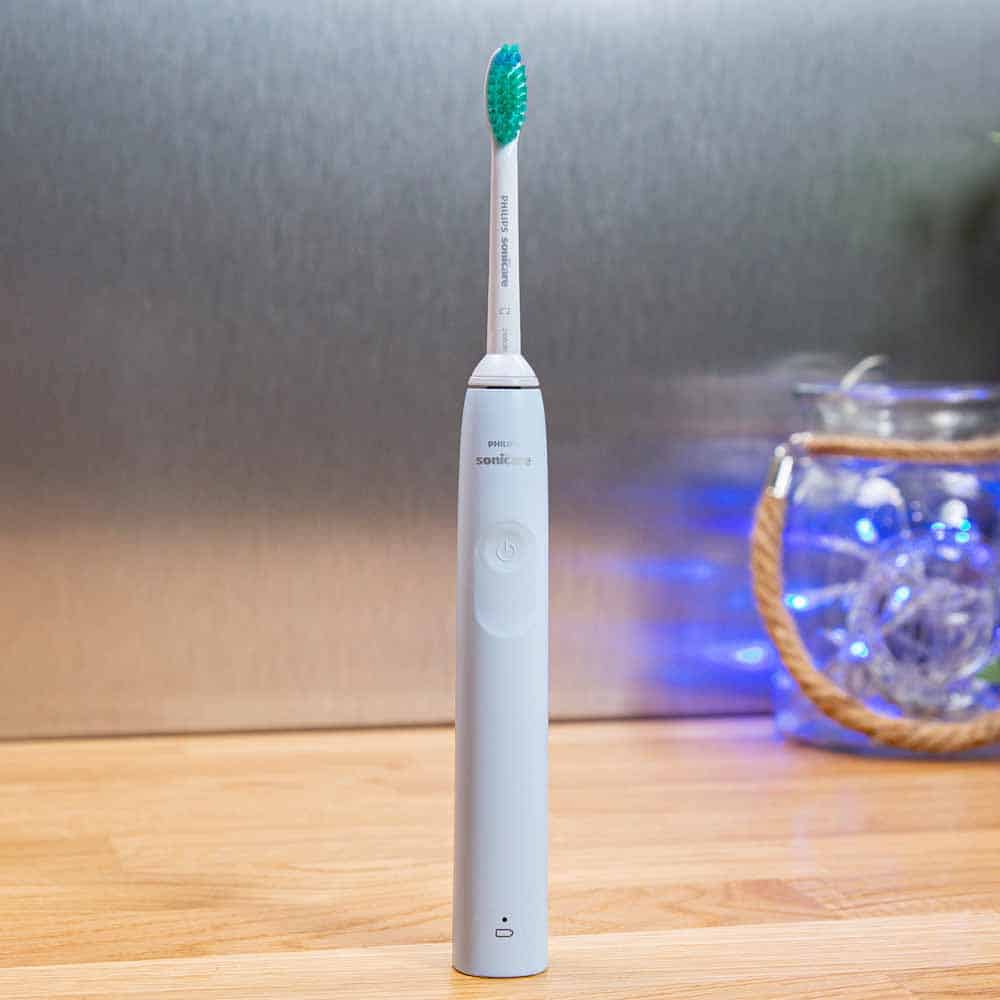
It’s less powerful than most sonic brushes but still cleans well
The motor that moves the bristles of the brush head is tuned differently to the motors found in premium Sonicare models. It doesn’t achieve the 62,000 movements of some of Sonicare's more expensive brushes.
It means the 2100 doesn’t offer quite the same intensity and deep clean feeling when in use. But, unless you have used a Sonicare toothbrush before, you’d have no reason to question it. The sonic vibrations give a thorough and clean feeling.
Cleaning results are not impacted. They are most definitely comparable and perfectly satisfactory.
I’ve got no complaints and your dentist won’t either, providing you use the brush correctly.
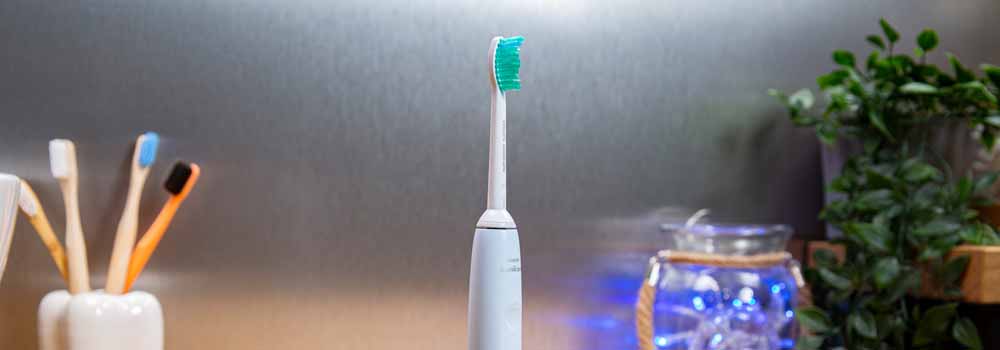
The W2 Optimal White brush head does a good job of cleaning all over the tooth surface and along the gumline. It’s designed to help buff away surface stains on the teeth.
It’s one of a number of different styles of Sonicare brush heads that are compatible with the 2100 Series. We’d generally pick the ProResults over the OptimalWhite.
If you have a small mouth, a sonic toothbrush might not be right for you. The oval heads tend to be larger than the oscillating-rotating counterparts from Oral-B.
Satisfactory 2 week battery life on a full charge
17 days is the average usage time I’ve achieved with the 2100.
A few days longer than the 14 claimed by Sonicare, this is perfectly satisfactory. Yet, the performance of the rechargeable Lithium-Ion (Li-Ion) battery is below the market average of 3-4 weeks.
The slimmer profile likely has a bearing but isn’t necessarily justification alone. Other slim handled brushes outperform here, but they may cost more.
An LED in the handle of the brush changes colour and flashes to give feedback on the remaining charge. This is very valuable in daily use. Previous affordable Sonicare models have lacked such.
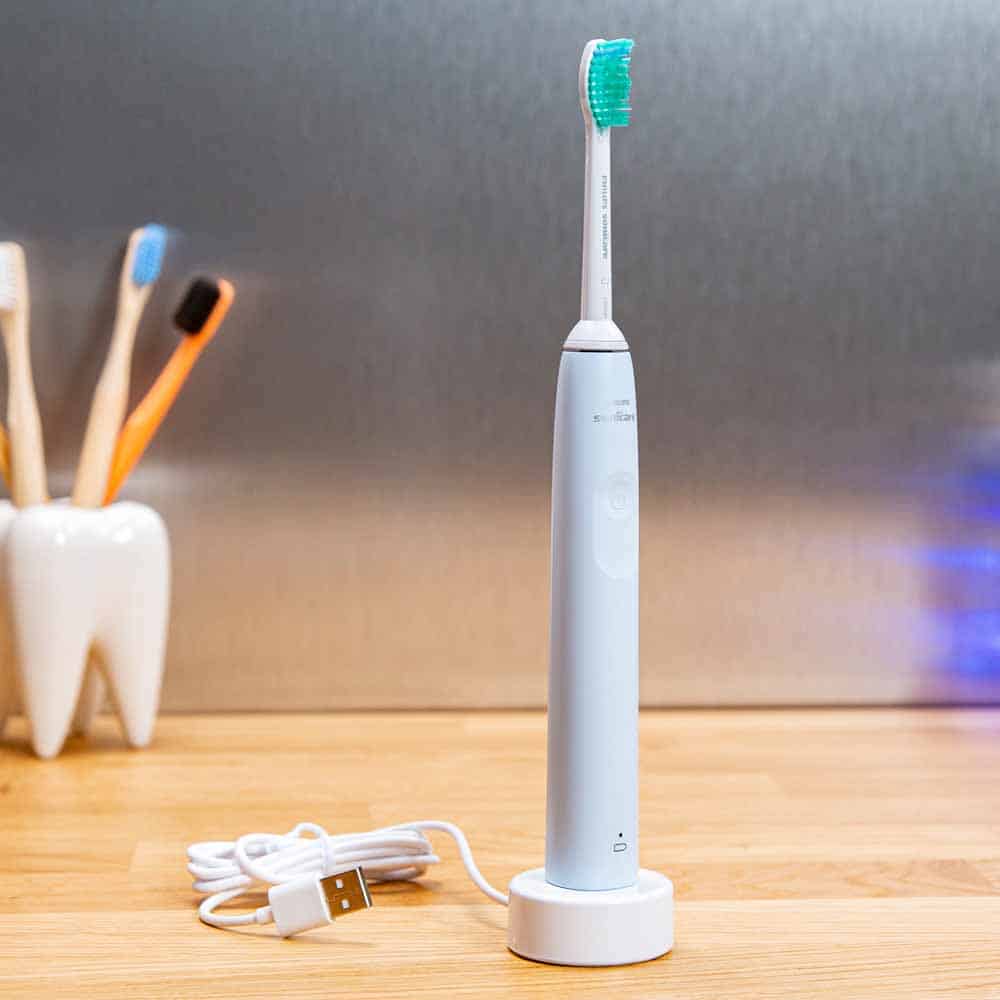
USB charging makes it more difficult for some
The included charging stand is different from what existing Sonicare toothbrush users might be used to.
It is now smaller and lighter with a circular design. A 110cm USB cable is hardwired into it rather than a 2 pin power adapter.
A protuberance on the top still exists to fit into the base of the handle.
Taking up to 24 hours to charge the brush, the stand is more travel friendly. But, it poses an issue if you want to charge in your bathroom. No 2 pin USB power adapter is provided. It’s excluded for environmental reasons.
Most of us now have USB power adapters that can be used. Your smartphone or other tech gadgets likely came with one. Or because it has a USB connector, you can take advantage of powering it from more sources such as a computer or portable battery bank.
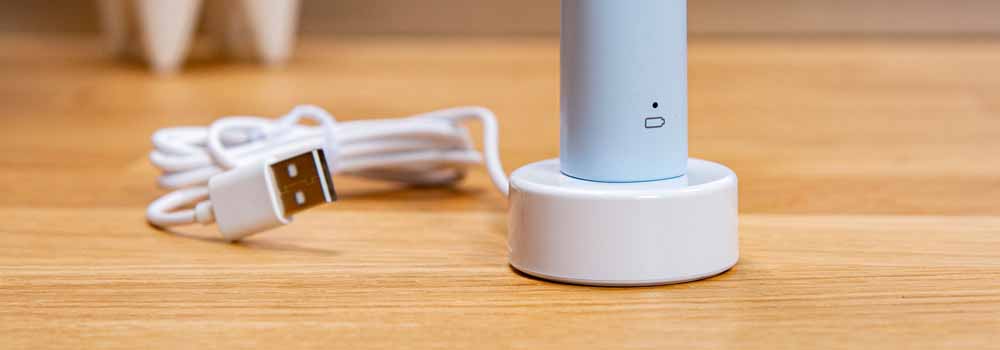
2 year warranty included as standard
An industry average 2 year warranty against defects and workmanship is provided.
Budget brushes like the 2100 can often come with compromises. Thankfully reliability doesn’t appear to be one that applies. It seems well built with no reason to suggest it wouldn’t last a good few years.
Disappointingly, in an era where environmental impact is important, the 2100 has no serviceable parts. There is no ability to undertake a repair without rendering it useless.
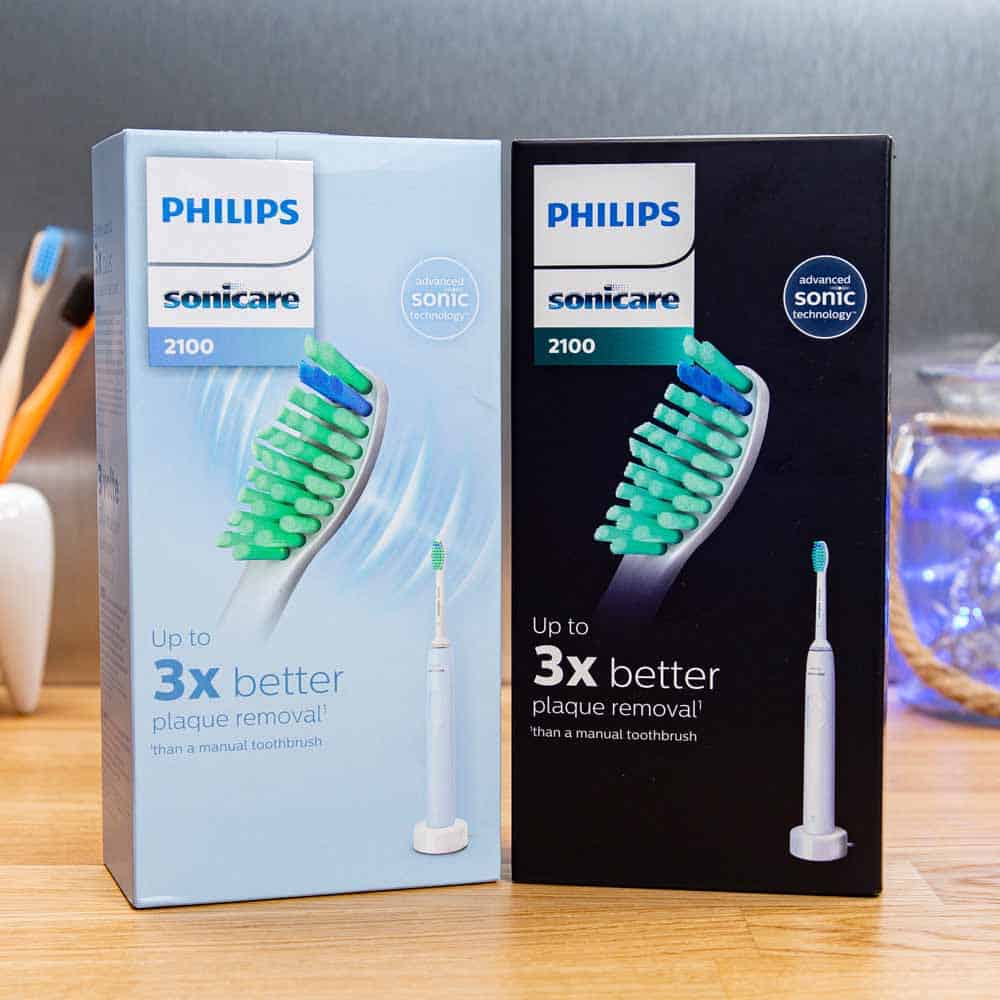
Environmental impact
We don’t know the exact environmental impact of the 2100, the data isn’t available. However, as a general rule, the impact of electric toothbrushes is around 11 times more than a manual brush.
Given the lack of unnecessary extras, the 2100’s impact shouldn’t be much different to the average brush.
It doesn’t have smart features or use Sonicare’s RFID enabled brush heads that use more of the planet's resources.
Impact is further reduced by excluding a 2 pin power adapter. But at odds with this is the lack of repairability and the fact that the handle and stand come wrapped in plastic.
Where some manufacturers now use plant based plastics, Philips heads primarily use petroleum based, thus using more of the finite resources,
Philips has partnered with schemes such as TerraCycle in some countries, but doesn’t have its own scheme.
Conclusion: functional and affordable
If you are on a tight budget and want a toothbrush from a leading brand, the 2100 Series is a good choice. The main downside is the lack of a pressure sensor.
It looks good, cleans the teeth well, and has 2 of the 3 dentist recommended features. It is our budget choice from the Sonicare range.
Size guide
- Toothbrush height with head - 23.4cm / 9.2 inches
- Toothbrush height without head - 17.3cm / 6.8 inches
- Width - 2.5cm / 0.9 inches
- Depth/thickness - 2.7cm / 1 inches
- Weight with head - 98g / 3.5oz
- Weight without head - 93g / 3.3oz
- Package weight - 255g / 9oz
Noise
- 60dB
Country of manufacture
- China



